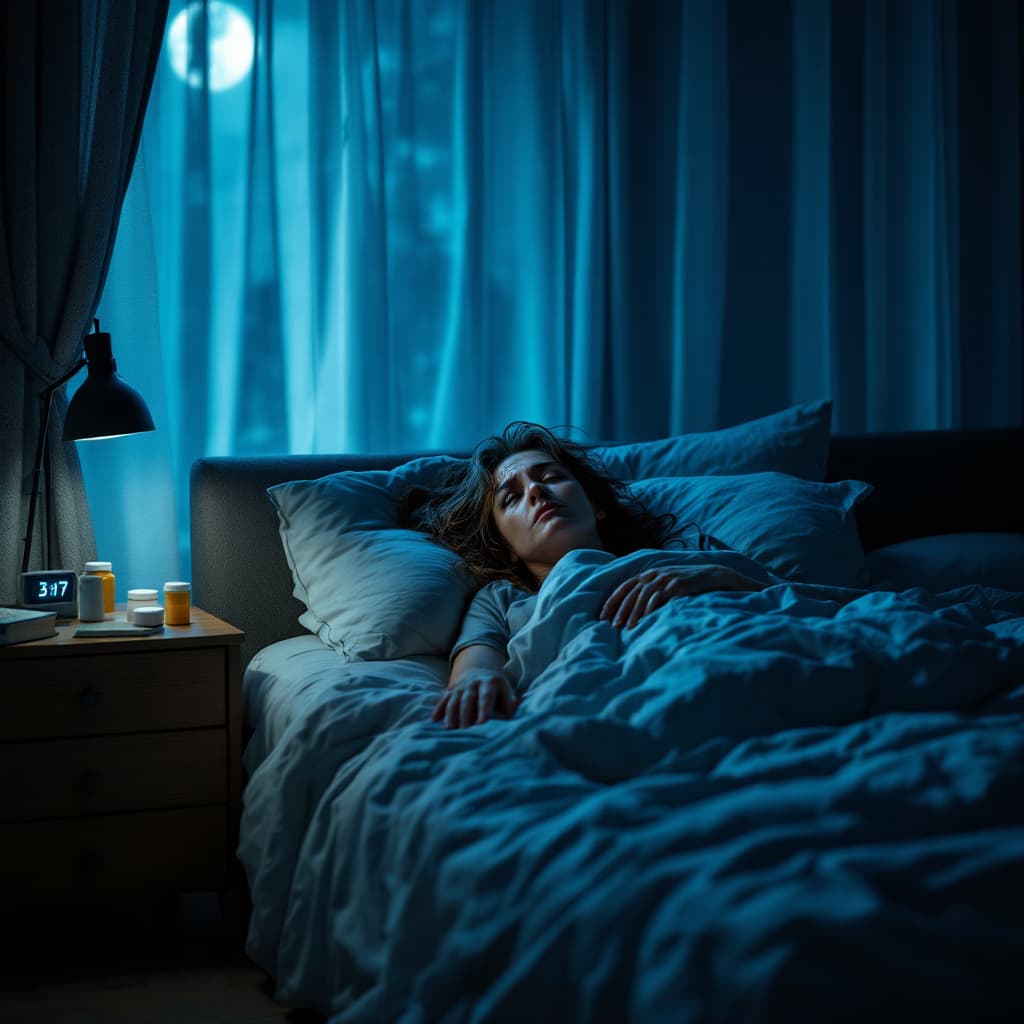Tin tức
Insomnia Treatment Plan: Simple Steps You Can Use Today
You can’t sleep again. Night after night you lay awake watching the clock and hoping sleep comes, but it doesn’t. In the morning you wake up and your head feels heavy, your body feels slow, and the day requires more than you have to give. If this sounds familiar you are not alone, millions of people suffer from poor sleep, but a solid plan could change your nights.
This guide helps you develop an individualized Insomnia Treatment Plan for your life. You will learn about causes of insomnia, such as bad habits, stress, and health conditions. You will gain practical steps you can start today, when you need to see a doctor.
You will receive some practical structure to follow that relates to your routine, environment, and behavior. You will learn how to create a consistent sleep schedule, create a wind down routine, and control light, noise, and temperature. You will learn the ways caffeine, alcohol, and late screens influence your sleep and what to do instead.
You will also learn clinically proven techniques that are part of cognitive behavioral therapy for insomnia (CBT-I). CBT-I is a method to target thoughts and behaviors to get to sleep. Clinically, it’s effective, safe, works in many situations, and can be combined with real habits.
Eventually, you will have a plan you can repeat through steps with confidence. Experience tells us, little victories, slow progress, to build stronger days and better nights. Tips as small as you need, track what works, and reflect on when you feel better. You can achieve better sleep, just make sure you have clear plans.
Understanding Insomnia: The First Step in Your Treatment Plan
Insomnia means you have trouble falling asleep, staying asleep, or waking too early. It affects how you feel during the day and how you function at work, home, and in relationships. Getting clear on your insomnia symptoms and the causes of insomnia helps you build an Insomnia Treatment Plan that actually fits your life.
Common Symptoms You Might Notice
Watch for patterns that show up at night and during the day. These signs point to insomnia and guide what to change first.
- Taking 20 minutes or more to fall asleep: You lie in bed and feel stuck, which can raise stress and push sleep even further away. This often leads to a slow start the next day.
- Waking up multiple times: You fall asleep but keep popping awake, which breaks deep sleep. You may feel foggy and less productive at work.
- Waking too early and cannot return to sleep: Your sleep window shrinks, so you miss REM and deep sleep. Mood and focus usually suffer.
- Not feeling rested after sleep: Even a full night feels light or shallow. You may notice irritability or low energy.
- Relying on naps or extra caffeine: Short-term fixes mask the problem and can make the next night harder.
Track these signs for two weeks. Note bedtimes, wake times, wake-ups, naps, caffeine, and stress. This record helps you tailor your Insomnia Treatment Plan and measure progress.
What Causes Insomnia in the First Place
Insomnia rarely has a single cause. It often comes from a mix of stress, habits, health issues, and environment.
- Psychological: Anxiety, depression, or worry loops in bed. Example, replaying work issues at night.
- Medical: Pain, asthma, reflux, thyroid problems, menopause, or medications that stimulate. Example, decongestants late in the day.
- Environmental: Noise, light, room temperature, or an uncomfortable mattress. Example, street noise or a bright alarm clock.
- Habits: Late caffeine, alcohol near bedtime, irregular sleep times, or screen time in bed.
Many causes overlap, so your plan should target the root. Start with what seems most true for you, then adjust based on your sleep log. This steady, focused approach reduces symptoms and supports lasting change.
Building Your Personalized Insomnia Treatment Plan
A good Insomnia Treatment Plan starts with self-assessment, then moves into focused action. You do not need a perfect routine on day one. You need clear data, smart goals, and methods that match your needs. When you build it step by step, you gain better sleep, steadier energy, and a calmer mood.
Step 1: Track Your Sleep Habits for a Week
Start with a simple sleep diary. Use a free app or a notebook. Record the same details every day to spot patterns that affect sleep.
Track these items:
- Bedtime and wake time: Include time in bed and time asleep.
- Sleep quality: Rate 1 to 5, with 5 as best.
- Night awakenings: How many times and for how long.
- Caffeine, alcohol, and nicotine: Include type, amount, and time.
- Exercise: Type, duration, and time of day.
- Screens and light: Evening screen time and light exposure.
- Stress or pain: Brief notes on mood or discomfort.
- Naps: Start time and length.
This log reveals links, like late caffeine leading to longer sleep onset, or heavy dinners causing restless nights. It becomes the foundation of your Insomnia Treatment Plan and helps you measure progress.
Step 2: Set Realistic Sleep Goals
Use your diary to set goals you can meet most days. Aim for steady habits over quick fixes.
Good targets include:
- Consistent schedule: Same wake time every day, even weekends.
- Sleep window: Plan 7 to 9 hours in bed based on your needs.
- Wind down: A 30 to 60 minute pre-sleep routine.
- Cutoffs: No caffeine after early afternoon. No screens for 60 minutes before bed.
Avoid perfection. Start small, such as moving bedtime by 15 minutes each week. These goals guide choices in therapy and lifestyle changes within your Insomnia Treatment Plan.
Step 3: Choose Treatments That Fit You
Pick methods that match your patterns and causes.
Core options:
- CBT-I: Structured sessions that address thoughts and behaviors. Includes sleep restriction, stimulus control, and sleep education.
- Relaxation: Diaphragmatic breathing, progressive muscle relaxation, or brief guided imagery.
- Lifestyle: Morning light, regular exercise, and a cool, dark, quiet room.
- Medication: Short-term use only, with medical guidance, when symptoms are severe or other steps are not enough.
Start with non-drug methods. Adjust based on your diary and goals. Keep what works, remove what does not. This keeps your Insomnia Treatment Plan personal, practical, and effective.
Lifestyle Changes to Boost Your Insomnia Treatment Plan
Small daily choices can strengthen your Insomnia Treatment Plan and make other treatments work better. These changes act like natural insomnia remedies that support your body’s sleep drive. Keep your room cool, dark, and quiet. Set a steady wake time. Then layer in the habits below. Imagine drifting off easily after a relaxing evening walk.
Create a Soothing Bedtime Routine
A calm routine trains your brain to expect sleep. Start 60 minutes before bed and repeat it every night.
- Dim lights to reduce stimulation and cue melatonin, your sleep hormone.
- Read a paper book or listen to soft music. Keep content calm.
- Practice deep breathing. Try 4-6 breathing, inhale for 4, exhale for 6, for 5 minutes.
- Take a warm shower, then step into a cool room to nudge your body toward sleep.
Avoid screens in the last hour. Blue light blocks melatonin and keeps your mind active. This simple routine supports your Insomnia Treatment Plan without meds by lowering arousal and easing the transition to sleep.
Diet and Exercise Tips for Better Sleep
What and when you eat and move affects sleep pressure. Use these easy wins.
- Limit caffeine after noon. It can linger for 6 to 8 hours.
- Choose a light evening meal. Heavy, spicy, or late dinners can cause reflux and wake-ups.
- If hungry near bedtime, pick a small snack, like yogurt or a banana.
- Exercise most days, earlier in the day. Aim for 20 to 40 minutes of brisk walking, cycling, or strength work.
Exercise tires the body in a healthy way and improves deep sleep. Placing workouts earlier also lets your body temperature drop by bedtime, which supports your Insomnia Treatment Plan.
Manage Stress to Prevent Sleepless Nights
Stress keeps your nervous system on high alert. Reduce it before bed to improve sleep.
- Journaling: write tomorrow’s to-do list and one worry with one next step.
- Meditation apps: use a 10-minute body scan or guided breathing.
- Social support: talk with a friend or partner to release tension.
Stress is a common cause of insomnia. Lowering it reduces nighttime awakenings and racing thoughts. These habits pair well with CBT-I and enhance results from your Insomnia Treatment Plan by calming the mind and body.
When to Seek Help: Professional Insomnia Treatment Options
If poor sleep lasts longer than a month, brings daytime sleepiness, affects mood or work, or raises safety risks, it is time to seek professional insomnia treatment. A clinician can confirm insomnia, check for medical or mental health conditions, and match you with proven tools. You are not alone, and treatment works when it is part of a clear Insomnia Treatment Plan.
Therapies That Really Work for Insomnia
CBT-I is the first-line therapy for chronic insomnia. It helps you change thoughts and habits that keep you awake, then rebuilds a dependable sleep routine.
- Sleep restriction: Limit time in bed to match actual sleep, then expand as sleep improves.
- Stimulus control: Use the bed only for sleep and intimacy, get up if awake longer than 15 minutes, return when sleepy.
- Cognitive skills: Replace worry and sleep myths with balanced, practical thoughts.
- Sleep education and relaxation: Learn sleep basics, add breathing or muscle relaxation.
You can access CBT-I with a trained therapist or through structured apps that follow clinical protocols. Many people combine weekly sessions with a sleep diary and home practice inside their Insomnia Treatment Plan.
Other helpful options:
- Light therapy: Timed bright light helps shift workers or people with delayed sleep schedules. Use morning light to anchor your wake time, and keep evenings dim.
- Partner treatments: Address snoring or suspected sleep apnea with a sleep study when needed.
Medications and Natural Supplements
Medication can support short-term relief while therapy does the heavy lifting.
- Melatonin: Useful for jet lag or shift work. Take a low dose, 0.5 to 3 mg, 1 to 2 hours before bed.
- Prescription sleep aids: Options include non-benzodiazepine hypnotics or low-dose sedating antidepressants. Use the lowest effective dose for the shortest time. These can cause tolerance or dependence, so follow your doctor’s plan and avoid alcohol.
Natural aids can play a small role:
- Chamomile or valerian: May provide mild calming effects. Quality varies by brand.
- Magnesium glycinate: Can relax muscles in some people.
Always talk with your doctor to check interactions and dosing. Medications and supplements work best as part of a balanced Insomnia Treatment Plan that centers on CBT-I and steady daily habits.
Conclusion
You now have an Insomnia Treatment Plan that is clear, and you can use it with conviction. You understand the usual reasons for insomnia, you can build a plan that works in your life, and you can use practical changes to promote sleep. You know when to seek help, and how therapies like CBT-I, light therapy or a trial of medicines can be part of a safe, gradual process. This system allows you to target what works, and limits the trial and error. The aim is continued progress, less restless nights, and better days.
Keep your plan simple and regular. Get up at the same time, use a calming wind down routine, and avoid sleep disruptors such as late caffeine and screens. The sleep diary that you used here, will help you decide, and keep track, so you can see patterns and make adjustments early. If you notice loud snoring, gasping for air at night, unresolved pain, or ongoing low mood, get in touch with a health care provider. A correct diagnosis improves ounces and solidifies your insomnia plan.
Take action now, not later. Take a notebook or open an app, and start a sleep diary tonight, to set the stage for better sleep tomorrow. Write down your bed time, wake time, night wake ups, caffeine, and stress levels. Small steps lead to action. What one thing will you change this week? Good sleep is demoable, and your Insomnia Treatment Plan can help you get there.

Có thể bạn quan tâm
Itees Global | Seasonal Game-Day Gear Shopping Picks 2025 – Cool Graphic Tops, Sweatshirts & More
🎄 Christmas Sports Apparel Shopping Guide 2025 – Cool Printed Tops, Jackets [...]
Ignite Your Inner Hitmaker: Dive Into Professional Trap Production with Break It Down
In the dynamic world of music production, where grooves land like fire [...]
Chi phí giao dịch Forex Phí qua đêm (Swap) Ảnh hưởng trực tiếp đến lợi nhuận
Phí giao dịch trên thị trường forex là những chi phí bắt [...]
Khám Phá Tranh Canvas Làng Quê: Trang Trí Nhà Cửa Gần Gũi, Ấm Áp
Trong guồng quay hối hả của cuộc sống hiện đại, con người [...]
Insomnia Treatment Plan: Simple Steps You Can Use Today
You can’t sleep again. Night after night you lay awake watching the [...]
Các yếu tố kinh tế cốt lõi ảnh hưởng đến tiền tệ.
Giá trị tiền tệ và lợi nhuận giao dịch trung – dài [...]